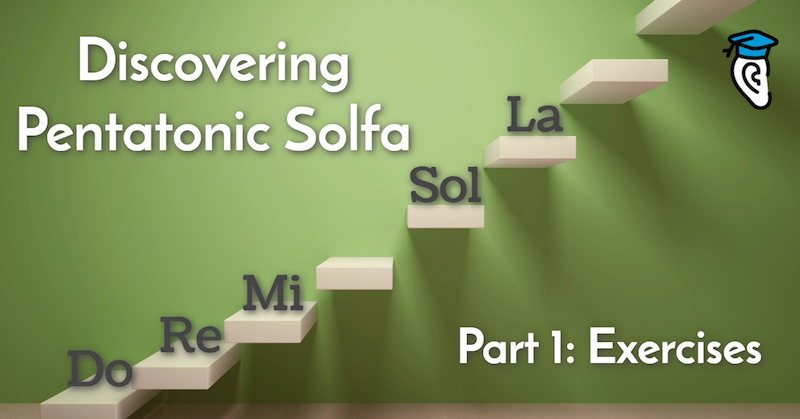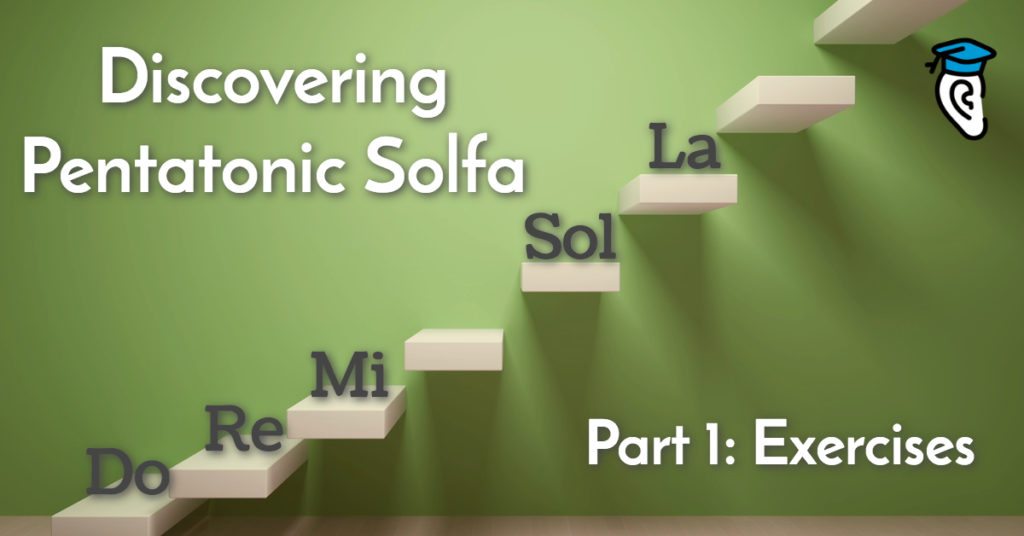Have you been looking for a magical tool to transfer the music you hear to the music you play on your instrument? Solfa (aka solfège, or solfeggio) can be that secret weapon that helps you hear exactly what note is being played. If solfa is new to you, check out these beginner solfa exercises.
Most of the time, we think of solfa in terms of the diatonic scale. But the same system can be applied to one of the most popular scales today, and of all human history: the pentatonic scale.

Once we’re well practiced with these exercises, we’ll move on to real music in Part 2.
Finding your tonic in pentatonic songs
The solfa “language” relates each note to the tonic, so finding the tonic is always the first step. In the diatonic scale, you are helped by strong gravitational pulls towards the tonic, but in the pentatonic scale, the tonic can be less obvious.
What’s so important about the tonic?
Finding the “home” of a song is the starting point of learning a melody and playing it by ear transcribing it. Any musician, either amateur or professional can benefit from thinking of music from a graphical point of view. That means to imagine the score while hearing the music and to translate what you hear in a solfege.
Knowing your tonic is like north on a compass: once you’ve found the tonic, you can find everything else. Knowing the tonic is fundamental to so many things you’ll want to do with music:
 The tonic gives you a starting point for transcribing music.
The tonic gives you a starting point for transcribing music.- Knowing the tonic helps you play by ear in real time without having a score.
- The tonic helps you understand music patterns which help you compose, accompany and memorize music.
So we’ll start with finding the tonic. If you’re already good at this, follow along anyway because the rest of what we do today will build off these first exercises.
→ Learn more about finding the tonic
How to do the exercises
You will be singing. Don’t worry about how your voice sounds. You don’t have to be Celine Dion! Don’t interpret the melodies: merely use your voice as a tool to help you translate what you hear into notes.
Later you will transform the whole process from a sing-and-play process to a hear-and-play one. Be patient, you are going to get there. It’s only a matter of putting in the time.
There is a solfa way of “thinking the score”: when you hear the tonic, you think “do” and from there you also learn to recognize how “re” or “mi” or the other steps in the scale sound. Soon you’re hearing and identifying exactly what all the notes are. Play what heard on your instrument and now you’re playing accurately by ear. It’s like you’re “reading” the music you hear.
So all you have to do is poke around a little and figure out which note is “do” and all the rest falls into place.
From Tonic to Pentatonic
Enough dreaming, let’s go to work, because even when you wish upon a star, dreams come true only when you work for them.
Let’s move on to our first exercise and follow the steps for identifying the correct notes. This is a step-by-step process, so please don’t skip ahead even if it seems easy.
Listen to our first melody:
This is the tonic:
Find this note with your voice and observe how it feels. Is it in your lower, medium or higher register? If you know your voice, it’s easy to find the corresponding sound on your instrument. If not, look for it on your instrument while you sing it with your voice. Listen to what happens there.
Now that you know “do”, extract the scale of the song. Identify the notes on your instrument and repeat the scale five times, while singing the solfa syllables. If you find this step difficult, listen to the scale first, then sing and play:
Now try to make the correspondence between the notes heard in the scale and their order of appearance in the melody. Hum them, look for them on your instrument, and then name them. Write them down as you hear them because you don’t want to forget what you heard.
Now sing along the melody with solfa:
Compare what you sang with the next example.
Find the notes on your instrument. Compare what you obtain with the original score:

The Pentatonic Scale
There are only five pitches used. This is a pentatonic scale (penta=five, tonos=sound), a five-sounds scale.
It’s a shorter version of the diatonic scale, in which the fourth and the seventh are missing. This gives songs an open sonority because both the seventh and the fourth are very close to the basic elements of the scale. The seventh is the leading tone – resolving by a half-step up to the tonic. The fourth is one half-step higher than the third of the scale, which is very important because the third determines whether you are working with a minor or a major scale.
Half steps have a very important role in the scale’s tonal attraction. You can think of them as having a strong magnetic pull which gives the scale a directional quality. When we exclude the half steps we obtain a sonority that can be described as uncertain.
So, in solfa terms, the pentatonic scale is “do-re-mi-sol-la-do”
It is a very well known musical scale, present in all types of music – folk, jazz, blues, classical music, pop, and so on – and it seems to have been present throughout music history.
The “weak gravity” of the pentatonic scale (opposed to the well-affirmed gravitation of the diatonic scale) served the classical composer Claude Debussy very well to create “impressions” of a state of spirit or mind, without affirming it clearly.
Practice Exercises in Pentatonic Solfa
Let’s continue our exercises with the same pattern of work, following the same steps.
Pentatonic Solfa Practice Melody 2
Listen to Melody 2 and identify the tonic:
Show answer
Now, from the tonic, figure out your solfa scale. Sing it a few times.
Show answer
Since you know the tonic, transfer your solfa scale to real notes:
Show answer
This will be useful later when we transcribe the melody and/or play it on our instruments.
Now listen again to “Melody 2” and try to identify how the notes from the scale are used. Then sing the melody in solfa. The explanations from the first example are still valid, so don’t hesitate to go back if at any point you get lost.
Tip: Also remember that some of the notes from the scale might be one octave higher or lower than the ones from the melody.
Once you think you have it, compare what you sang with the next example, which reproduces the melody with solfa:
Show answer
Since we’ve already determined the real notes of the scale, we can transfer our solfa to real notes and use them to transcribe the melody to a score. Try it yourself, then check your answer:
Show answer

Don’t worry if you didn’t find all the notes this time around. You’ll learn to find them in time.
Pentatonic Solfa Practice Melody 3
Let’s keep the same steps for the next examples:
Listen for the tonic:
Show answer
Determine the solfa scale:
Show answer
Transfer the scale to real notes:
Show answer
Sing the melody in solfa:
Show answer
Transcribe and/or play on your instrument:
Show answer

Pentatonic Solfa Practice Melody 4
Let’s keep the same steps for the next examples:
Listen for the tonic:
Show answer
Determine the solfa scale:
Show answer
Transfer the scale to real notes:
Show answer
Sing the melody in solfa:
Show answer
Transcribe and/or play on your instrument:
Show answer

Although in the melodic line we find only the pentatonic scale, the harmony might suggest the diatonic scale, and then we have the entire key. In the pentatonic scale alone, the attraction is very weak so you might find it hard to feel the tonic.

We can include the harmony notes to reconstruct the whole scale of the example:
Pentatonic Solfa Practice Melody 5
For the last exercise, we will return to the pentatonic scale. Follow exactly the same steps as the previous exercises.
Listen for the tonic:
Show answer
Determine the solfa scale:
Show answer
Transfer the scale to real notes:
Show answer
Sing the melody in solfa:
Show answer
Transcribe and/or play on your instrument:
Show answer

Congratulations! Your ears have just completed quite a workout! Now you’ll start to recognize these five pentatonic steps everywhere. In Part 2, we’ll move on to pentatonic solfa exercises with real music. Until then, listen everywhere for pentatonic scales and sing solfa for as much of what you hear as you can.


 The tonic gives you a starting point for transcribing music.
The tonic gives you a starting point for transcribing music.




